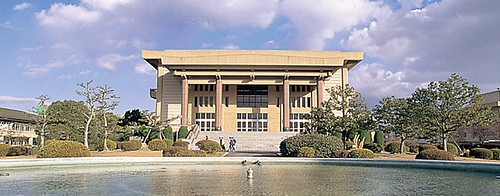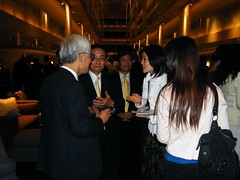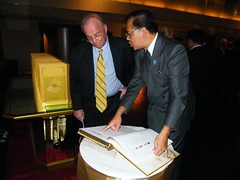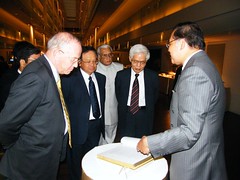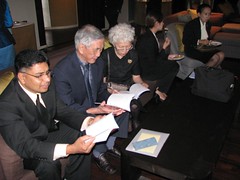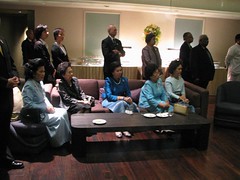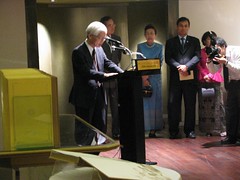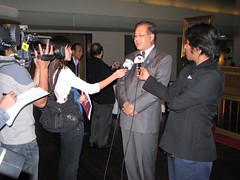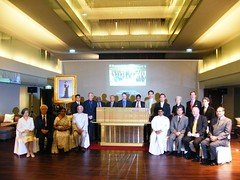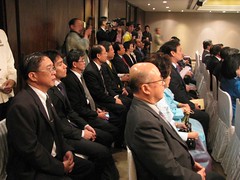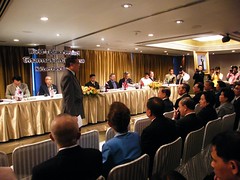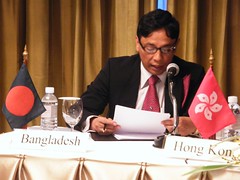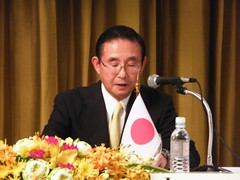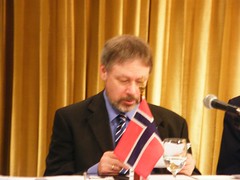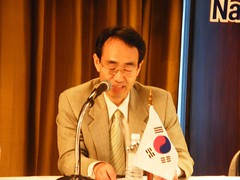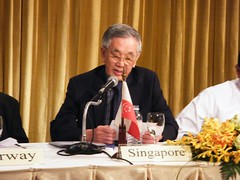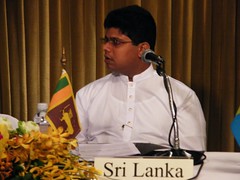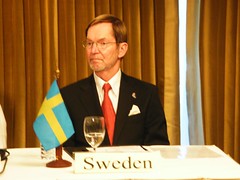The World Tipiṭaka Presentation Ceremony
Aichi Kakuin University, Nagoya, Japan
21 November B.E. 2551 (2008)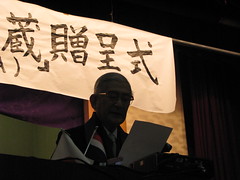
Acceptance Speech
御礼のご挨拶
First of all, I would like to express my deepest sorrow about the demise of Her Royal Highness Princess Galyani Vadhana Krom Luang Naradhiwas Rajanagarindra, Honorary President the World Tipiṭaka Presentation to Leading International Institutions worldwide.
I am happy and honoured to welcome all of you who have kindly visited Nagoya, Japan, a place so far away just a few days after the cremation of Her Royal Highness to present 40 volumes of the latest Pāḷi edition of the World Tipiṭaka Council in the Roman Script, for which I am sincerely grateful.
The study of the Pāḷi Tipiṭaka in Japan around the end of the 19th century started with the lecture by Professor Tagakusu Junjiro who had studied in England. Subsequently Professor Nangai Magato and Master Misuno Kogen, a teacher to whom I am greatly indebted, have developed it. Several universities such as Komazawa, Taisho, and Otani universities have produced quality personnel who have been doing researches until many Pāḷi researchers from all over Japan have collaborated and succeeded in translating the Pāḷi Tipiṭaka into Japanese called “Nandendaiso Scripture” consisting of 65 volumes and 70 issues.
Later when World War II ended in 1945 Japan was in a ruinous and pathetic state. I entered Tokyo University in 1947 and started to learn Pāḷi immediately. There were very few documents in the research room and no Pāḷi dictionary could be found. In 1960 I began to search for Pāḷi documents from all over the world and started to collect them since then. At present my library is the best source in Japan. Now that I have received the latest Pāḷi edition of the World Tipiṭaka Council in the Roman Script from Thailand, my research room is complete and I am elated. Thank you very much.
Now I would like to ask permission to clarify some points.
At the time when the Buddha was still alive (around 5-6 centuries before Christ) a powerful Kingdom in India was Māgadha. The Buddha might have spoken the ancient Māgadha language. Buddhist Theravāda Tradition in Southern India believes that the language has changed to Pāḷi. The word “Pāḷi” means “Scripture” but theoretically during the spread of Buddhasāsana from Magadha in East India to West India it could be said that Pāḷi was used as the language of the scripture three centuries before Christ. In the reign Emperor Ashoka, Buddhasāsana and Pāḷi spread from India to Sri Lanka and further on to Burma (present-day Myanmar), Cambodia, and Laos.
Not long after the Buddha had attained Nibbāna, 500 enlightened monks assembled at the holy cave. It was the first time that such a mass assembly took place to revise the Tipiṭaka. The Sixth Great Tipiṭaka Council in 1956 to commemorate the 2500th anniversary of the Buddhist Era took place in Yangon, Burma. A great number of Buddhist monks came from all the countries that have inherited Buddhist Theravāda Tradition. They compiled the Scripture by reciting the Tipiṭaka in unison. The outcome of that assemblage was the publishing of the Pāḷi Tipiṭaka in the Burmese script and this sixth revision was held to be the principal Scripture for Buddhist Theravāda Tradition. However, not long after the publishing of the Tipiṭaka, Burma underwent political changes so the project has not progressed since.
The latest Pāḷi edition of the World Tipiṭaka Council in the Roman Script from Thailand, even though based on the manuscript in the Burmese script, has also been compared with more than 18 scriptures published in various countries and analysed by over 50 technical experts in computer engineering who spent three years revising and editing it. It is Thailand’s gratifying and great project of the century. The organisation assigned to undertake the project was the M.L. Maniratana Bunnag Dhamma Society Fund under the Patronage of His Holiness the Supreme Patriarch of Thailand, supervised by its Chancellor, Major Suradhaj Bunnag, who has kindly joined today’s event.
From another approach, Buddhasāsana spread from the northwest of India via the Silk Road into China, Korea, and Japan, and was known as the Northern Buddhasāsana. Since the time of the Buddha, Buddhasāsana in India had split into several sects. The tradition of Buddhasāsana originated when the Buddha was alive had developed into Mahāyāna and Vajarayāna sects of Buddhasāsana. At the end of the 12th century Buddhasāsana disappeared from India. At present modern Buddhasāsana in India has been restored via Sri Lanka. A part of Mahāyāna Sect has spread southward, but the Southern Buddhasāsana has been propagated through the conservation of the original Buddhasāsana in the Pāḷi language.
As for the Northern Buddhasāsana, most of the Buddhist scriptures belonging to traditional Mahāyāna Sect used Sanskrit as the language of Dhamma. The original Buddhist Scripture conveying the teaching of the Buddha had been translated into the northern Chinese script as “Agama Sutra.” Since Mahāyāna Sect prospered a great deal, there had been numerous translations of Mahāyāna scriptures. Japanese researchers have always been seriously doing research on the birth and transmission of Mahāyāna Sect. There are several parts that are still not well known and all the Mahāyāna scriptures have not yet been assembled and summed up. The Pāḷi Tipiṭaka has been clearly compiled so we know that it is the authentic compilation of the Buddha’s teachings. Judging from the birth of this Pāḷi Tipiṭaka, it can be concluded that it is the principal scripture, the foundation derived from a direct transmission from the Buddha.
Buddhasāsana in Japan is divided into sects, each of which has its own founder. Thus, the Buddha is often forgotten. It is not necessary to emphasise that the Buddha gave birth to Buddhasāsana. No leader of any sect stands on his right-hand side. We should all reconsider this point. All sects of Buddhasāsana in the world hold the Buddha to be the most excellent, whether Dougenzenshi or Shinranshounin or Nichirenshounin, would agree with this truth.
I would like to return to where I left off. When we listen to the Pāḷi Tipiṭaka, we feel as if we were listening to the Buddha himself, for example, when he was delivering Dhamma Discourse to his disciples he would call them bhikkave, bhikkave. I think that this characteristic of the Buddha’s speech has been transmitted in the original without any adaptation.
After the Great East-Asian War Japan has re-established the country’s economic conditions. At the same time the Pāḷi research has also progressed, with valuable research works and many new translations being published on a regular basis. Most of them were translated from the books of Pali Text Socity in London. Later there were several translations from the Burmese script of the Great International Tipiṭaka Council (the Sixth Council in Burma). In the near future I absolutely hope that there will also be researches on and translations of this latest edition of the Great International Tipiṭaka Council in the Roman Script -- “The World Edition” -- from Thailand.
At present, the Pāḷi research in Japan has taken the Suttantapiṭaka, Vinayapiṭaka, and Dhammapitaka from the Tipiṭaka to be examined together with historical documents, documents concerning grammar, and relevant references. The research works and their Japanese translations are regularly publicized. We think that we would be able to present these references to you in the near future. I believe that reading the reference will enable one to deeply and correctly understand the Tipiṭaka from another perspective.
In general, each of the countries in Southeast Asia that adhere to Buddhist Theravāda Tradition would publish the Pāḷi Scripture in their own language, which is a normal practice for each country. When I was teaching graduate students of Pāḷi, I made them do a research on four types of scripts: Thai, Burmese, Sinhala of Sri Lanka, and Devanagari of India on their own for two years. After that they had to take a Pāḷi reading comprehension test twice a year or at the end of the first and second terms. My exams consisted of all four types of scripts, which was very depressing for the students. However, I think that from now on only two types of scripts, Thai and Sinhala, should be enough.
The publishing of this latest Pāḷi edition of the World Tipiṭaka Council in the Roman Script is the first of its kind accomplished by Asians as a meritorious project to disseminate the Buddha’s words to be known worldwide. I believe that Japan’s research, though a bit late, must be continually developed.
In 1988 there was a Pāḷi research in our own country. Researchers interested in Buddhist culture from all places assembled to found the Society for the Study of Pāḷi and Buddhist Culture. Academic seminars are organised annually and the society’s journal called the “Journal of Pāḷi and Buddhist Culture” is regularly issued. At present there are altogether 220 members including members from abroad. It is the only academic society in Japan with expertise in Pāḷi that joins the Science Council of Japan, an agency that organises activities under the Prime Minister’s Office. The society has set its sights on doing activities in the form of academic exchanges among a great number of researchers, with special interest in the Buddhist Theravāda Tradition in foreign countries.
Apart from academic research, the recent movement in Japan worth paying attention to is that the dynamic Buddhist Theravāda Tradition is continuously developing. I myself appreciate this movement and have been observing it with interest. In countries in Europe which is the world of Christianity, there are numerous temples, Dhamma and meditation centres in operation. In Asia, Islam and socialism have clashed, causing difficulty. As a participant in a research on Buddhasāsana, I care very much about the present situation.
Buddhasāsana has the Buddha as the founder. The Tipiṭaka is a sacred scripture that has directly transmitted the Buddha’s words. Buddhasāsana in countries around the world has started from the same point of origin and developed and spread worldwide, which at present the world has reached a time of crisis. What can Buddhasāsana offer to help rescue it from all perils? All the Dhammas concerning Morality from the Five Precepts, the Eight Precepts, the Four Noble Truths, to the Noble Eightfold Path are all very crucial. I would like to suggest the following four issues for consideration.
1. According to the Life of the Buddha, He was born, walked by himself on lotus blooms, meditated until he attained enlightenment and became the Buddha. From that time on he had become the Tathāgata who taught to render benefit to the world, human beings and non-human, the first and foremost Teacher who had made Buddhasāsana complete.
2. In a competitive society such as the one at present, it should be accepted that anyone who can win over himself should be considered a true “Jina” or conqueror according to the Buddha’s teaching.
3. People in the world have unanimously talked about sustainable development, but it should be accepted that man’s ability to repress his defilements and cravings and adhere to Santuṭṭhi or sufficiency is also a way leading to becoming a true human being just like the Buddha’s way of leading his life with only the three pieces of cloth and one begging bowl.
4. The worst situation in the world is waging war. We should accept the highest merit of Nibbāna that in the Buddha’s lifetime there were at least two times that he had learned from the effort to prevent war and bring peace to the world.
These are the four issues that I would like to present.
Even though the Spaceship called Earth which shares the same fate as all human beings should come to the worst, I believe that the thing which can show the way to real happiness is the Pāḷi Scripture. All Buddhists should trace their way back to the foundation of Dhamma in the Pāḷi Scripture taught by the Buddha and search until they find Buddhasāsana in a new perspective from that point.
The 40-volume Pāḷi Tipiṭaka is deemed as mankind’s truly invaluable treasure. I would like to express my sincerest respect and thanks for your goodwill and perseverance in bringing them to Nagoya, Japan, which is such a faraway place.
Finally, I hope that the presentation of the latest Pāḷi edition of the World Tipiṭaka in the Roman Script will create a firmer bond between Thailand and Japan. I would like to thank representatives from the Japan Theravāda Buddhist Association who have dedicated themselves to coordinating with the city of Nagoya and the various institutions and universities in Tokyo and Kansai District. My special thanks go to President of the Japan Theravāda Buddhist Association, Mr. Junichi Konishi, who has always been giving his support.
21 November 2008
Maeda Kegakku
President of the Society for the Study of Pāḷi and Buddhist Culture
パーリ学仏教文化学会会長
前田恵學
